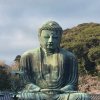Torii are the ‘gates’ to Shinto shrines, called jinja in Japanese. During my travels, I often noticed Japanese people bowing before they entered the shrine’s grounds - the places of Kami or Shinto gods.
Torii have similar construction - two cross beams are held in place by two side supports, and the ‘gates’ do not have flaps. The shape of the cross beams vary from very simple geometric designs to more curved and elaborate ones. But overall, the shape of torii is well recognized.
The very first torii I came across was the torii at Meiji Jingu shrine in Tokyo. I was amazed and impressed by the size – it was just majestic! Then I encountered an even bigger one – the torii of Itsukushima Jinja shrine, standing in the waters of Hiroshima Bay. When those torii are in water their size isn’t as obvious as it is with people standing nearby during low tide. However, torii are not always that big. Small shrines have torii that are as small and low as a doorway.

The quantity of torii also varies from a single one, to several, to hundreds like you'll find at Motonosumi Inari Jinja in Yamaguchi Prefecture, or even thousands at Fushimi Inari Taisha in Kyoto.

Old torii are made from wood and are often painted in bright red or red-orange colors. Sometimes old torii are made from bronze, such as the torii at Enoshima Shrine. Many old torii were destroyed in numerous fires and wars, and later were replaced by concrete or metal torii. Torii made from bronze or concrete are usually left unpainted, and I particularly like old wooden unpainted torii as they look closer to nature. Sometimes, another symbol of Shinto – shimenawa – are placed on torii.
I liked the torii arches standing in the water at Hama Lake in Bentenjima - they seemed to open the way to the Pacific Ocean. The highest torii I've visited belonged to Fujisan Hongu Sengen Taisha and was located on the top of Fuji-san. I managed to climb half way to the 9th Station, and the photo of the simple wooden torii is my object of pride!













































































The torii gates at Meiji Jingu impress me every time. Such beautiful, strong wood, and elegant shape.